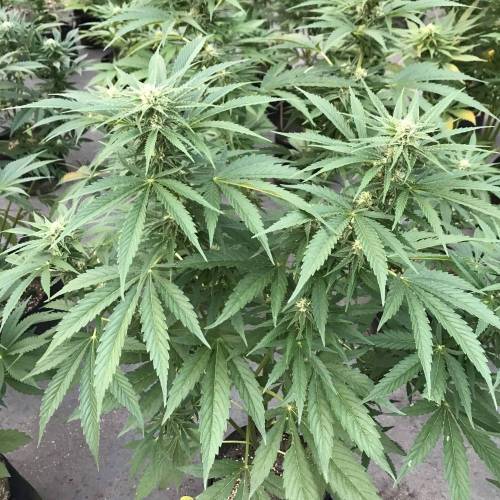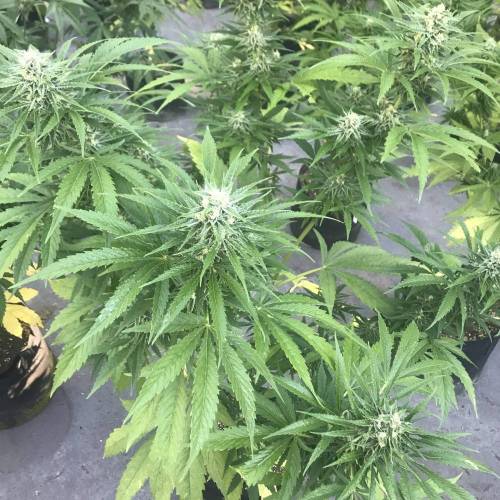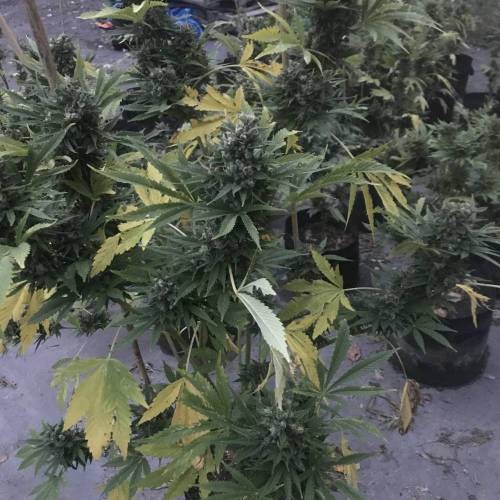The Grow Awards 2026 🏆 







22 Gorilla Gelato
Soil
Custom
Perlite
Custom
Compost Other
Custom
Outdoor
Room Type
Main-Lining
weeks 4
27 liters
Pot Size
Start at Harvest
G
Germination4y ago
Northern_Ent May 13: still early enough to start photoperiods for outdoor. Two of my favourite strains combined in Gorilla Gelato. It will be interesting to see how this compares to Expert Seeds Gorilla Glue x White Widow which were started about four weeks ago.
1 like
2 comments
Share
Used method
Glass Of Water
Germination Method
1
Week 1. Vegetation4y ago
17 hrs
Light Schedule
25 °C
Day Air Temp
6.4
pH
22 °C
Night Air Temp
Northern_Ent I’m very excited for this strain. My Gorilla Glue x White Widow plants are doing great in this cool spring weather and I love Gelato so this cross should be very good.
I’ll be topping and probably mainlining all photoperiods unless I’m running out of time but looks good so far. Will force flower for 3 weeks starting July 4 so I only have about six weeks of veg phase the get it big enough. Maybe I’ll delay forcing Fast flowering ones by a week or two.
May 25: both into 5 gallon bags.
likes
comments
Share
2
Week 2. Vegetation4y ago
17 hrs
Light Schedule
20 °C
Day Air Temp
6.4
pH
22 °C
Night Air Temp
likes
comments
Share
3
Week 3. Vegetation4y ago
17 hrs
Light Schedule
20 °C
Day Air Temp
6.4
pH
700 PPM
TDS
24 °C
Solution Temp
5 °C
Night Air Temp
26.5 liters
Pot Size
Northern_Ent June 2: looking good.
2 likes
comments
Share
4
Week 4. Vegetation4y ago
15.24 cm
Height
17 hrs
Light Schedule
20 °C
Day Air Temp
6.4
pH
700 PPM
TDS
24 °C
Solution Temp
5 °C
Night Air Temp
26.5 liters
Pot Size
Nutrients 7
Yucca extract
0.1 mll
Extreme Blend
0.391 mll
Epsom salts
0.651 mll
Northern_Ent June 14: mainlined in between rain storms, or rather between varying intensity of rainstorms.
1 like
comments
Share
Used techniques
Main-Lining
Technique
5
Week 5. Vegetation4y ago
15.24 cm
Height
17 hrs
Light Schedule
20 °C
Day Air Temp
6.4
pH
700 PPM
TDS
24 °C
Solution Temp
5 °C
Night Air Temp
26.5 liters
Pot Size
Nutrients 7
Yucca extract
0.1 mll
Extreme Blend
0.391 mll
Epsom salts
0.651 mll
3 likes
1 comment
Share
6
Week 6. Vegetation3y ago
15.24 cm
Height
17 hrs
Light Schedule
20 °C
Day Air Temp
6.4
pH
700 PPM
TDS
24 °C
Solution Temp
5 °C
Night Air Temp
26.5 liters
Pot Size
Nutrients 7
Yucca extract
0.1 mll
Extreme Blend
0.391 mll
Epsom salts
0.651 mll
Northern_Ent June 27: looking good.
1 like
1 comment
Share
7
Week 7. Vegetation3y ago
35.56 cm
Height
17 hrs
Light Schedule
20 °C
Day Air Temp
6.4
pH
600 PPM
TDS
40 %
Air Humidity
24 °C
Solution Temp
10 °C
Night Air Temp
26.5 liters
Pot Size
Nutrients 7
Yucca extract
0.1 mll
Extreme Blend
0.391 mll
Epsom salts
0.651 mll
Northern_Ent These photoperiod plants look good. It would have been nice for them to be a month or two older but still should be okay. Will start force flowering all photoperiods soon.
July 3: added malt and Power Bloom.
likes
comments
Share
8
Week 8. Vegetation3y ago
58.42 cm
Height
17 hrs
Light Schedule
20 °C
Day Air Temp
6.4
pH
600 PPM
TDS
40 %
Air Humidity
24 °C
Solution Temp
10 °C
Night Air Temp
26.5 liters
Pot Size
Nutrients 6
Yucca extract
0.1 mll
Extreme Blend
0.391 mll
Epsom salts
0.651 mll
Northern_Ent July 9: started force flowering (12 h darkness).
July 10: looks good.
likes
comments
Share
9
Week 9. Flowering3y ago
96.52 cm
Height
12 hrs
Light Schedule
24 °C
Day Air Temp
6.4
pH
600 PPM
TDS
40 %
Air Humidity
24 °C
Solution Temp
10 °C
Night Air Temp
26.5 liters
Pot Size
Nutrients 6
Yucca extract
0.1 mll
Extreme Blend
0.391 mll
Epsom salts
0.651 mll
likes
comments
Share
10
Week 10. Flowering3y ago
116.84 cm
Height
12 hrs
Light Schedule
24 °C
Day Air Temp
6.4
pH
600 PPM
TDS
40 %
Air Humidity
24 °C
Solution Temp
10 °C
Night Air Temp
26.5 liters
Pot Size
Nutrients 6
Yucca extract
0.1 mll
Epsom salts
0.651 mll
Blackstrap Molasses
0.651 mll
Northern_Ent July 25: force flowering continues until the end of the month.
Looking good. They also seem fairly big for their age.
July 26: switched to gypsum as Ca source.
July 28: last night of 12:12 light cycle.
likes
comments
Share
11
Week 11. Flowering3y ago
121.92 cm
Height
16 hrs
Light Schedule
24 °C
Day Air Temp
6.4
pH
600 PPM
TDS
40 %
Air Humidity
24 °C
Solution Temp
10 °C
Night Air Temp
26.5 liters
Pot Size
Nutrients 8
Yucca extract
0.1 mll
Epsom salts
0.651 mll
Blackstrap Molasses
0.651 mll
Northern_Ent July 31: added second round of Power Bloom and malt as top dressing.
Soluble wood ash is being added to water for potassium. Mixing fresh wood ash from the fire pit into RO water and then lowering pH with vinegar. Using a 1.5 L container, I mix in 6-8 spoonfuls of ash which gives a pH way over 10. Add vinegar to get pH near 6 and the TDS will be at about 1600 ppm. When this is mixed into 1000 L tank it raises TDS by 10-20 mg/L. Repeat as needed.
Wood ash is mostly calcium carbonate but that is less soluble than potassium which is the next most common element at about 4%. So the part that dissolves quickly is mostly K and any extra soluble Ca and P is a bonus.
Wood ash is typically added to soil or compost but solubilizing it works and fits the nutrient program. Online people suggest letting it steep as a tea but the K is what I want and it’s highly soluble so there’s no need to wait for it to dissolve (or steep as a tea).
Aug 1: at scale, about 2 kg of ash (about 10 cm layer) in bottom of a 20 L (5 gallon) pail is mixed with RO water to nearly fill the pail. Stirred and then about 500 mL of vinegar is needed to lower pH to near 6. Any ash that floats or sinks is composted. The TDS of the dissolved ash solution is about 1500-1800 ppm and this is then added to 1000 L tank. Starting with 2 kg of ash at 4% K (40,000 mg/kg) this would provide a maximum of 80 g of K. So, in 20 L that is 4,000 mg/L, and in 1000 L it is 80 mg/L of K. Sounds about right, but might want to repeat to raise K further if desired. Once dissolved everything seems to stay in solution and I have not seen any precipitates forming in the main tank, nor would I expect any as this should be highly soluble.
1 like
4 comments
Share
12
Week 12. Flowering3y ago
121.92 cm
Height
16 hrs
Light Schedule
24 °C
Day Air Temp
6.4
pH
Normal
Smell
700 PPM
TDS
40 %
Air Humidity
24 °C
Solution Temp
10 °C
Night Air Temp
26.5 liters
Pot Size
Nutrients 6
Yucca extract
0.1 mll
Epsom salts
0.651 mll
Blackstrap Molasses
0.651 mll
Northern_Ent Aug 7: these plants were started a bit later than most of the other photoperiods but you can hardly tell. Nice size for their age and seems to be maturing nicely. These plants are moving up in my informal ranking of favourite plants this year (Bubble OG, Hash Bud, Gorilla Gelato, Peanut Butter Herijuana, Candyland, Perp Walk). Aww who am I kidding, I love them all.
likes
comments
Share
13
Week 13. Flowering3y ago
121.92 cm
Height
16 hrs
Light Schedule
24 °C
Day Air Temp
6.4
pH
Normal
Smell
700 PPM
TDS
40 %
Air Humidity
24 °C
Solution Temp
10 °C
Night Air Temp
26.5 liters
Pot Size
Nutrients 6
Yucca extract
0.1 mll
Epsom salts
0.651 mll
Blackstrap Molasses
0.651 mll
likes
comments
Share
14
Week 14. Flowering3y ago
121.92 cm
Height
15 hrs
Light Schedule
24 °C
Day Air Temp
6.4
pH
Normal
Smell
700 PPM
TDS
40 %
Air Humidity
24 °C
Solution Temp
10 °C
Night Air Temp
26.5 liters
Pot Size
Nutrients 4
Yucca extract
0.1 mll
Epsom salts
0.651 mll
Kelp and Humic Blend
0.26 mll
Northern_Ent Aug 26: nearing end. Stopping molasses and wood ash.
likes
comments
Share
15
Week 15. Flowering3y ago
121.92 cm
Height
14 hrs
Light Schedule
24 °C
Day Air Temp
6.4
pH
Normal
Smell
700 PPM
TDS
40 %
Air Humidity
24 °C
Solution Temp
10 °C
Night Air Temp
26.5 liters
Pot Size
Nutrients 4
Yucca extract
0.1 mll
Epsom salts
0.651 mll
Kelp and Humic Blend
0.26 mll
Northern_Ent Very nice plants.
2 likes
1 comment
Share
16
Week 16. Flowering3y ago
121.92 cm
Height
13 hrs
Light Schedule
20 °C
Day Air Temp
6.4
pH
Normal
Smell
40 %
Air Humidity
20 °C
Solution Temp
6 °C
Night Air Temp
26.5 liters
Pot Size
Nutrients 5
Yucca extract
0.1 mll
Epsom salts
0.651 mll
Kelp and Humic Blend
0.26 mll
Northern_Ent Sep 5: still good but they also seem to have re-vegged a bit rather than continue flower. Our long days and the quite warm weather must be doing it. Some plants did not re-veg.
Sep 7: late season hailstorm but no significant damage to these plants aside from trichome loss. Very unusual to get hail this late - it’s usually a June-July risk. But it had been over 30 C three days in a row prior to a cool day and then the hail on Sep 7. Not expected anyway and it surprised me but weather comes off the east slope of the Rocky Mountains to us here in the foothills and it can change very quickly.
Others plants like potatoes react well to late hailstorms so I’m not too worried about this aside from loss of some fan leaves to power growth.
Sep 8: first round 225 g wet. This is definitely a favourite plant this year. Excellent buds and lots of them.
1 like
comments
Share
17
Week 17. Flowering3y ago
121.92 cm
Height
13 hrs
Light Schedule
20 °C
Day Air Temp
6.4
pH
Normal
Smell
40 %
Air Humidity
20 °C
Solution Temp
6 °C
Night Air Temp
26.5 liters
Pot Size
Nutrients 4
Yucca extract
0.1 mll
Epsom salts
0.651 mll
Kelp and Humic Blend
0.26 mll
Northern_Ent Sep 14: took most of plant 1 and plant 2 is still going. Second round of 250 g wet, and 475 g so far.
Sep 18: took 120 g from plant 1 for total of 595 g. I think all of that is from plant 1 but there might be a couple tops in there from plant 2.
1 like
comments
Share
18
Week 18. Flowering3y ago
121.92 cm
Height
13 hrs
Light Schedule
20 °C
Day Air Temp
6.4
pH
Normal
Smell
40 %
Air Humidity
20 °C
Solution Temp
6 °C
Night Air Temp
26.5 liters
Pot Size
Nutrients 4
Yucca extract
0.1 mll
Epsom salts
0.651 mll
Kelp and Humic Blend
0.26 mll
Northern_Ent Sep 18: awesome strain continues to impress..very nice buds.
1 like
3 comments
Share
19
Week 19. Flowering3y ago
121.92 cm
Height
12 hrs
Light Schedule
24 °C
Day Air Temp
6.4
pH
Normal
Smell
40 %
Air Humidity
20 °C
Solution Temp
6 °C
Night Air Temp
26.5 liters
Pot Size
Northern_Ent Sep 28: seem ready but the weather is still nice so keep going.
Sep 29: took 753 g in third round. This finished plant 1 and most of plant 2. Total wet of 1,348 g wet so far.
likes
comments
Share
20
Week 20. Flowering3y ago
121.92 cm
Height
12 hrs
Light Schedule
24 °C
Day Air Temp
6.4
pH
Normal
Smell
40 %
Air Humidity
20 °C
Solution Temp
6 °C
Night Air Temp
26.5 liters
Pot Size
Northern_Ent Oct 4: a few buds remain but basically done.
Oct 8: took final 80 g wet for a total of 1,428 g wet from two plants.
likes
comments
Share
20
Week 20. Harvest3y ago
Happy Harvest Day!

10/10
Rated
Awesome plant and possibly my all time favourite. Both plants grew quickly after a late start and had no real problem with cool overnight temperatures that slowed most plants. Sustained some hail damage on Sept 7 but still finished strong. First season trying manifolding and it worked great producing eight colas on these plants. Would likely be a great commercial plant.
Show more
Translate
Spent 142 days
Ger Veg Flo Har
714 g
Bud wet weight per plant
183 g
Bud dry weight per plant
2
Plants
Easy
Difficulty

Creative, Happy, Uplifted
Positive effects

Cream, Diesel, Earthy
Taste
Height
Day air temperature
Air humidity
PPM
PH
Light schedule
Solution temperature
Night air temperature
Pot size
Northern_Ent Great plant produced lots of very nice buds. All star genetics for sure. Congrats to Ganja Farmer for this one and all their other genetics too. They have very good stuff.
3 likes
1 comment
Share
Equipment Reviews

the end.
Enjoying this diary? Follow for more updates!
Prefer the old Diary view?
Go back to the old Diary view




































































































































































































































